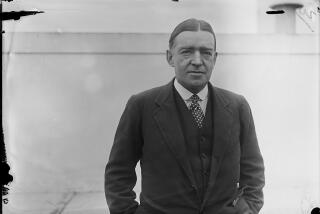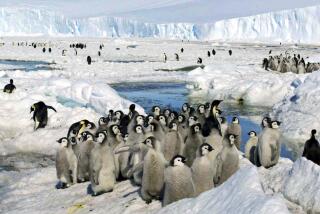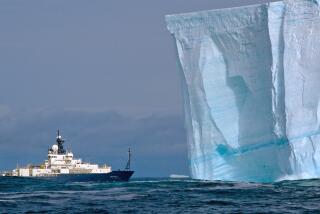Fragments of South Pole history crumble
- Share via
CAPE EVANS, ANTARCTICA — The dark, silent interiors of the three wooden huts are still pungent from the smoke of seal-blubber fires that once warmed men now long dead. Their dishes, pots, pans and scientific paraphernalia are scattered across tables and counters, and tins and boxes of their food still sit on shelves.
Strung out along 23 miles of Ross Island’s bleak coastline, the abandoned huts stood for decades as untouched relics of Antarctica’s heroic age of exploration. Next to the largest, the one at Cape Evans, lie the skeletal remains of a dog left behind when famous polar explorer Ernest Shackleton shut and locked the hut’s doors in 1917.
“They had only half an hour to pack and leave,” Al Fastier explained as the stocky New Zealander opened the hut to visitors one day last December. “They were in a hurry and shot him.”
For 90 years the dog’s carcass remained where it fell, a collar and chain still around its neck. For most of that time, much of the flesh and fur remained intact, preserved by Antarctica’s extreme cold. And though gale-force winds have beaten ice, snow and sea salt into the sides of the hut, the foodstuffs inside remained intact.
Now it appears a changing climate is threatening the history housed in these huts at the far end of the world, simple structures that many place among the greatest monuments to courage and the human longing for discovery.
With the weather warming on Ross Island, mold and fungi are blooming in all three of the explorers’ huts. They are rotting the timber of the huts and thousands of artifacts inside. The dog is now mostly reduced to a skeleton.
In addition, for the last six years Cape Evans has gotten tons of snow, far more than in the past. Last November, in the Antarctic spring, conservators discovered the roof of that hut was sagging under 84 tons of snow and ice, a third more than they’d ever seen accumulate before. Some support beams had cracked under the weight.
At risk are relics from four of the most famous expeditions in the annals of human exploration, two led by Englishman Robert Falcon Scott and two by his ex-lieutenant and rival, Shackleton. All four expeditions ended in failure, but their incredible stories of life-and-death struggles in the world’s harshest place still mesmerize millions, fueling a steady stream of new books and films.
When Scott famously froze to death 95 years ago while trying to wait out a blizzard in a tent pitched on the ice, he was desperately trying to return to the snug comfort of his personal cubbyhole in the Cape Evans hut, where his bedding, blankets, clothes, shoes and boots sit undisturbed after all these years.
“I defy you not to be interested when you open the door and step into one of those huts,” said Nigel Watson, executive director of the Antarctic Heritage Trust in Christchurch, New Zealand, a nonprofit group that is trying to protect the huts and the thousands of objects inside.
“It can be a very emotional experience,” Watson said. “I’ve seen people break down inside the buildings.”
The trust (www.heritage-antarctica.org), where Fastier works as a project manager, raised $5 million to conserve a hut Shackleton built at Cape Royds in 1908. Now, it’s now trying to raise $6 million for the Cape Evans hut.
There has been some talk of dismantling and moving the huts to London or New York, where they and the artifacts could be protected from the elements and exhibited for millions to see. As it is, they are visited only by a few hundred people a year, mostly scientists working in nearby research stations and hardy, wealthy tourists.
For now, however, the inclination is to restore and conserve them in place, but to increase access by installing remotely controlled live video cameras so they can be viewed at any time on the Web. Meanwhile, the effort to stabilize and stop the deterioration of the huts has caused scientists to stumble on valuable new research avenues, including the discovery of microorganisms that thrive in extreme cold.
The researchers making those findings are the scientific descendants of teams led by the early Antarctic pioneers, men of tremendous ambition and bravery.
In the early 1900s, Antarctica was an unknown entity. The world knew it was there, but nobody knew if it was a continent or a few islands and a lot of ice. They didn’t know whether the South Pole was like the North Pole, an ice-covered area of open ocean, or if it was on land.
Early Antarctic explorers were cut off for years.
“When they embarked on these expeditions, Christchurch was their Cape Canaveral,” Watson said. “Once they left here, there was no safety net or mission control to back them up. It was just a matter of, ‘Right, we’re off, and we’ll see you in three or four years.’ ”
The expeditions were packed with young biologists, meteorologists, geologists and physicists recruited by Scott and Shackleton to do research while the leaders pursued the real prize: being the first men to reach the South Pole.
The explorers needed shelters more substantial than tents, especially to survive brutal Antarctic winters when temperatures drop 100 degrees or more below zero and winds reach hurricane strength. The little wooden buildings they brought from overseas became the center of the men’s lives -- home, safe harbor, headquarters, workshop, laboratory and warehouse.
All three huts figured into the last grand effort of the era, the 1914-1917 Imperial Trans-Antarctic Expedition. With Norwegian explorer Roald Amundsen having won the race to the South Pole, Shackleton decided the next great feat would be to cross Antarctica coast-to-coast, passing over the pole on the way.
Shackleton sent 10 men to Ross Island with orders to build a line of supply depots from Discovery Hut, erected a dozen years earlier by Scott, into the interior toward the pole.
The plan called for Shackleton to lead a small party carrying enough supplies to walk to the South Pole from the other side of the continent, the Weddell Sea coast. They would then march to Discovery Hut, using supplies left at the depots by the other group of men.
As their headquarters, the advance party used the second hut Scott had built, at Cape Evans. But for shelter and scarce supplies the men also relied on Discovery Hut and on the hut Shackleton had built on a previous expedition at Cape Royds.
The depots were successfully established, but at a huge price: Three men died, and survivors suffered scurvy, snow-blindness, broken bones and amputated frost-bitten toes.
Meanwhile, they had no idea that Shackleton had lost his ship and was engaged in a famous struggle to rescue himself and his men. But by January 1917, they assumed he had died somewhere in Antarctica and resigned themselves to wait another year until someone else came to take them home.
On Jan. 10, a rescue ship unexpectedly steamed onto the horizon, with Shackleton aboard.
That was the day they shot the dog and left.
Over the decades, the dead dog became a sort of a talisman that visiting scientists would stop to photograph, creating a record that shows the cadaver remained remarkably stable for decades.
That began to change in the late 1980s, when summers began to get a little warmer on Ross Island.
Inside the huts, fungus and mold damage began to show up, affecting not only the wood but artifacts that had been preserved for decades, including fiber and leather clothing, glass containers, books and paper labels. The thousands of old tin containers of food have been at particular risk.
At Shackleton’s Cape Royds hut, cans were rusting open, spilling contents that fungi and mold quickly colonized.
“If temperatures are getting slightly warmer, the fungi will be the first to capitalize on that to colonize and decay wood and other substrates,” said University of Minnesota forest pathologist Robert A. Blanchette, whose research inside the huts is funded by the U.S. National Science Foundation. “We’re finding fungal blooms inside the huts that weren’t there before.”
Environmental monitors installed several years ago at the three huts have shown that during the brief Antarctic summer, when the air outside warms to 32 degrees Fahrenheit or slightly higher, the sun beating on the huts raises indoor temperatures considerably more.
The warmth melts the snow and ice, so water seeps through cracks in the huts, boosting humidity to more than 90%, Blanchette said.
This warm, humid indoor climate creates “a four- to six-week growing season” for the fungi, which go dormant as the huts cool, he said.
Blanchette and others are trying to determine if the rate of disintegration of the huts and their contents is accelerating. They know winter storms are intensifying, and the resulting accumulation of snow around and under the huts may be raising the indoor humidity higher than in the past.
Early in his investigation of the hut microbes, Blanchette noticed that many of the molds were not the ones he had expected to see attacking buildings in normal climates. DNA sequencing showed they were species previously unknown to science.
“These were not the usual white and brown rots, but were an unusual soft rot that could survive extreme cold and penetrate and grow inside the cell walls,” Blanchette said. “They are very tough organisms.”
One fungus turned out to be a dominant organism in the Antarctic soil. “This fungus apparently is an important degrader of organic material and nutrient recycling in Antarctica, and we know nothing about it,” he said.
Such discoveries are especially interesting to “bioprospectors,” or researchers who look at newly discovered species in hopes that the enzymes and chemicals they produce have useful properties that might be developed into important drugs or other products.
There is some interest in using enzymes from the Antarctic fungi to clean up oil spills in cold climates, Blanchette said. Or they might end up in the world’s laundry rooms.
“Cold-tolerant enzymes might be useful as stain removers,” he said, since most stain-removing enzymes now in use need hot water to work.
As for saving the wood in the huts from the molds, Blanchette said: “Normal wood preservatives seem to not work on these, so to slow them down, we’ve had to try to change the environment in the huts to make them less conducive to growth. If we can exclude the moisture, we can slow down the growth a lot.”
The Antarctic Heritage Trust is experimenting with equipment that can minimize humidity inside the huts year round. The trust is installing a protective lining behind boards and under the flooring to keep the original wood as dry as possible.
It also is looking for ways to minimize snow and ice buildup on the buildings, and is trying silicon-based coatings on exterior surfaces to protect the outer walls from further sun-bleaching and from the sandblasting of salt and ice when 100-mile-an-hour winds lash the huts.
In the meantime, the trust has begun to transport thousands of cans -- as well as artifacts including bedding, clothes, harnesses and utensils -- to a lab at New Zealand’s Scott Base.
Despite the obvious rust and decay of some of the cans and containers, much of the collection appears salvageable. A curator from New Zealand working with the old food supplies last year decided to open one of the intact cans of Irish brown stew and found “it still smelled pretty good -- like cat food.”
If lab workers can stabilize the corrosion, the artifacts will be reinstalled in their places, allowing future generations to marvel again at the history contained within the huts’ battered walls.
“Some of this material will be gone from the huts for five to eight years,” said Robert Clendon, a senior conservator with the trust. “But they will be conserved for 50 to 80 years once they are returned.”
More to Read
Sign up for Essential California
The most important California stories and recommendations in your inbox every morning.
You may occasionally receive promotional content from the Los Angeles Times.













